 |
||
|
||
| ||
Well, Yamaha remains one of the leaders in application and promotion of the latest technologies into the market. When the mass market just started offering drives capable of 2x rewriting Yamaha was promoting its CRW4416S model with the rewrite speed equal to 4X. Lately, the CRW8824EZ drive appeared to be the first series CD-RW drive that can rewrites CD-RW discs at up to 8x speed. But the matter is that at the time such innovations appeared and were actively promoted they far were not in great demand. The CRW4416S recorder first was not supported by the software for packet recording of Adaptec. That is, at that moment there was DirectCD 2.5a, and the support for the CRW4416S was featured only in the 2.5b version. Undoubtedly, there are some alternatives to the Adaptec software - e.g. the PaketCD of CeQuadrat. The PaketCD 2.10 "knew" the new Yamaha recorder when the latter appeared in mass sales, but surprisingly the speed gain in relation to 2X contestants was the lest beneficial. Not desiring to repeat the mistakes Yamaha debuted CRW8824EZ model having concluded contracts with the most software manufacturers on support for the drive in CD recording. But that time the company faced another problem: discs for higher than 4x rewriting were absent, and that lasted for quite long time. Unfortunately, not everybody profits by other's mistakes. A new CD-RW drive - the CRW2100E appeared when almost each confirmed readiness to meet the latest recorder. At least, it was said. But… With CD-RW discs for up to 10x rewriting the situation seems clearing up. But still, it's hard to say that the High Speed CD-RW discs are widely available today. Not better is the situation with just once recordable discs. Many CD-R manufacturers have already for a long time been adding stickers informing that their discs can be used for 16x record. Though in fact, it was only the end of the last year when Philips announced the Orange Book Part II CD-R Volume 2 Version 0.9 Multi Speed - a standard setting the writing speed of CDs up to 16X. Under such conditions it was only software manufacturers that kept their promises in realization of support for the newest recorder of Yamaha in their products. So, what have we got? Another bestseller or just an unnecessary toy? The tests will show. Let's see… For testing we took two recorders from different shipping lots and from different firms in order to make the examination as more objective as possible. The test procedure has a bit changed: apart from the CD-R Philips Silver Premium (1x-16x) which you should remember, we took the CD-R Mirex Gold (1-12X). 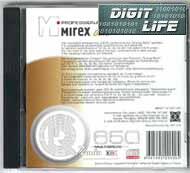 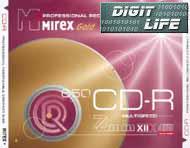 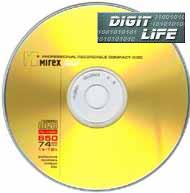 ATIP: 97m 28s 26f It allows more objectively look at record quality of different discs (including also an active layer - cyanin/phthalocyanine). As usual, you can find the drive description on a separate page. Yamaha CRW2100E
Test results
CDWinBench 99 CD-ROM Transfer RateFor comparison of performance in read operations we chose (beside the CD-ROM Teac 540E) the Plextor PX-W1210TA recorder.  In DMA mode the Yamaha just a little bit falls behind the CD-ROM Teac, the margin between the 32x Plextor and the CRW2100E is considerable. The matter is whether we can make use of this advantage considering as yet unstable work of the Yamaha CRW2100E in this mode. And when out of this mode the advantage of this recorder is not so striking, though the result is anyway higher.  There it becomes more thrilling: even that sample Yamaha CRW2100E, which we managed to carry out the WinBench 99 with in DMA mode, showed lower results than that of the 32x Plextor. So, what can say about the model that looks bad when in DMA mode... The CPU utilization was:  DMA, as being the Direct Memory Access, is intended for leaving the CPU in rest. And due to the incorrect operation of this mode on one of the recorders the results turned to be so much contrast. CDWinBench 99 CD-ROM Access Time Since absence/presence of DMA support doesn't influence the mean access time we introduce the average for the both models. The result is much better than claimed in the specs and a bit higher than that of the Plextor. CDWinBench 99 CPU Utilization Again, there tells upon impossibility to enable DMA-mode operation with one of the Yamaha recorders. The other drive (CRW2100E) takes the lead in this test. Time taken for CD recordingFor deeper comparison we took one more CD-RW drive with maximum 12X write speed - the TDK CyClone CDRW121032 - one of the leaders in record speed. Record of the CD-R Philips Silver Premium 16x (16x)  The difference between the fastest 12x recorder and the Yamaha CRW2100E is a bit more than a minute. Record of the CD-R Mirex Pro (12x)  Switching the Yamaha to 12X we will lose (if in the race CD-RW drives Plextor PX-W1210TA and TDK CyClone CDRW121032 will participate). Record of the CD-R Noname (4x)  At low speeds the Yamaha CRW2100E lags behind the contestants by a greater margin. Time taken for the full formatting of CD-RW disc in UDF formatPhilips CD-RW (4x)  The Yamaha CRW2100E formats the disc a bit speeder than its closest competitor Plextor PX-W1210TA. But comparing the received figures it will reveal the difference in only 9 seconds, what does not matter as compared with half an hour taken for the full formatting. CD-RW Ricoh (10x)  And formatting of the Ricoh disc for further 10x recording was more difficult for the Yamaha. Difference from the Plextor PX-W1210TA amounted nearly 4 minutes. Record of CD-RW disc (UDF)Philips CD-RW 4x  Ricoh 10x  Easy to see that work with CD-RW discs in UDF format is not ideal with the Yamaha CD-RW drive. The difference in some tests were more than 2 minutes. BLER mark for the recorded CD-R Philips Premium (16X write speed)
BLER mark of the recorded CD-R Mirex Gold (12X write speed)
BLER mark for the recorded CD-R Mirex Gold (16X write speed)
BLER mark for the recorded CD-R "Noname" (4X write speed)
(for testing we used a device described in the part V of the review) In addition to the basic testing we recorded the Mirex Gold's at the speed higher than established in the specification. It is explained, first, by the fact that at the time of testing the local market still had nothing to offer from CD-Rs which allowing writing at up to 16X (it was not so long time ago when CD-R discs from Verbatim and Philips (MultiPurpose) appeared on the market). Secondly, we wanted to find out whether the recording results are comparable with CD-R recorded at high speeds, produced by different methods, with usage of different active layer. I do not doubt in quality of CD-Rs produced by Taiyo Yuden. We just wanted get a conception how great is the potential of the technology of cyanine disc production and how great are the possibilities of enabling the resources that would allow recording the discs, based on this technology, at the speeds higher than 12X. Look at the figures - they will tell you everything. Just note that the scores of the both devices are similar. While testing the "BLERmeter" registered frequent marked leaps, what resulted in such an average value with high uncertainty. On receiving the results we were unpleasantly surprised with them, that's why we decided on sending the tested samples (Philips and Noname) in order to test them with the CDCATS SA3 station. The CD-R Mirex weren't in this list since we examined them a bit later (but on the same drives). The CDCATS printouts: 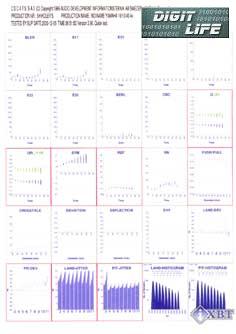 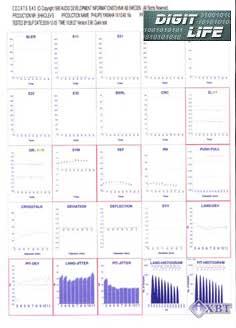 For the clarification on parameters, please refer here. CDTest 99For read graphs of other drives see the first four and the sixth part of the review. As we already mention the both drives were tight close in record quality, but they read discs differently. And as to the Teac CD-540E, it read discs almost equally. Graphs of reading of the recorded CD-R Philips Silver Premium (16X write speed)
As I mentioned one of the recorders hardly worked in DMA mode (it's marked (2)), but still we didn't succeed in getting it through the CDTest 99. In most cases the test was stopped with an error, and the graph looked like this: 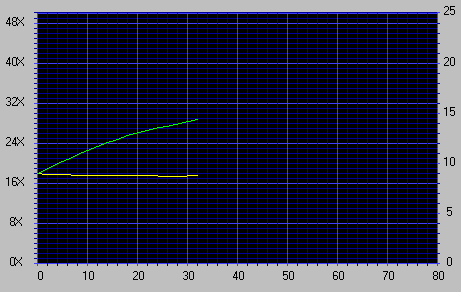 Here is the graph of reading for all discs on the CD-ROM Teac CD-540E :  Graphs of reading of the recorded CD-R Mirex Gold (12X write speed)
Graphs of reading of the recorded CD-R "Noname" (4X write speed)
The green line is a reading speed (left scale), the yellow one is a disc rotation speed, thousand rpm (right scale). Unbelievable - two drives that were supposed to be the twins "gladdened" us with completely different scores. The CD Speed 99 results of the recorded CD-R Philips Silver Premium
The CD Speed 99 results of the recorded CD-R Mirex Gold
The CD Speed 99 results of the recorded CD-R "Noname"
The CD Quality Check results of the recorded CD-RW (UDF) discs at 4x
The CD Quality Check results of the recorded CD-RW (UDF) discs at 10X
The CD Quality Check results of the recorded CD-RW (ISO) discs
Comparing the Yamaha CRW2100E with the TDK recorder for instance we can only say that the Yamaha reads CD-RW discs much better, and in any format. Unfortunately, it's one of the few of its advantages. The reading speed of the recorded CD-R Philips Silver Premium (CD Quality Check)
The reading speed of the recorded CD-R Mirex Gold (CD Quality Check)
The reading speed of the recorded CD-R "Noname" (CD Quality Check)
The result can be called satisfactory only for a good 32X model, and not only for a 40X one. Quality of the recorded CD-R Philips Silver Premium (CD-ROM Drive Analyzer)
Quality of the recorded CD-R Mirex Gold (CD-ROM Drive Analyzer)
Quality of the recorded CD-R "Noname" (CD-ROM Drive Analyzer)
The graphs of reading obtained with the CD-ROM Drive Analyzer are very similar to that of the CDSpeed 99, that is they are even, without noticeable falls. Like in the CDSpeed test, one of the recorders shows higher reading speed but less stable graphs than the second model. Audio track extraction from audio CDs (CDDAE 99)Piano Favorites
Acoustic Planet vol.2
Bloodhound Gang "Greatest Hits"
* - 11.1% means that the drive extracted 11.1% of the CD with errors. The results of testing in speed and correctness of extraction from the audio CD are successful. For many drives, we tested, the disc Acoustic Planet vol.2 turned to be very difficult, nevertheless the Yamaha managed to complete the task adequately - one more merit of the Yamaha CRW2100E. Direct copying from recorded CDs to the hard driveThis test is aimed to obtain more proper information, do not take it as the serious torture for the drive. Since the disc structure is nonuniform and compound, the results were quite low even for 40x devices. Copying of the recorded CD-R Philips Silver Premium  Copying of the recorded CD-R Mirex Gold  Copying of the recorded CD-R "Noname"  Reading of damaged CDs"Golden" CD: Yamaha CRW2100E (1) 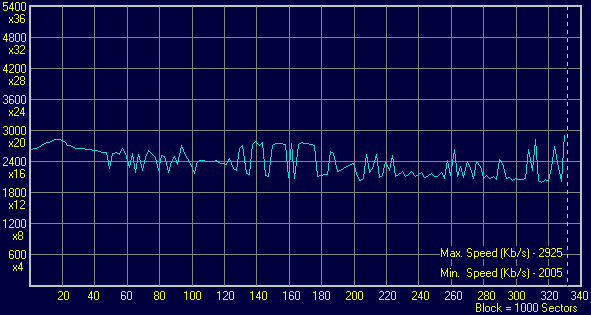 Yamaha CRW2100E (2) 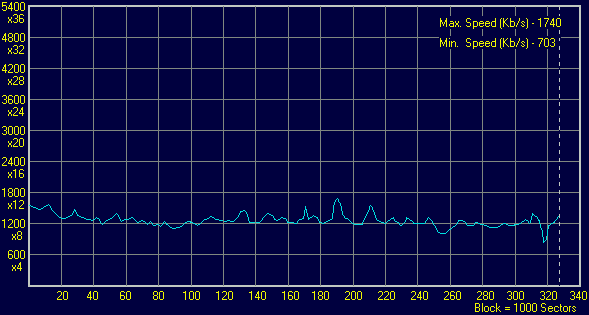 Scratched: Yamaha CRW2100E (1) 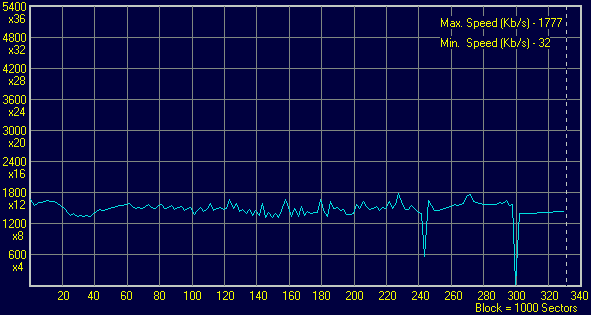 Yamaha CRW2100E (2) 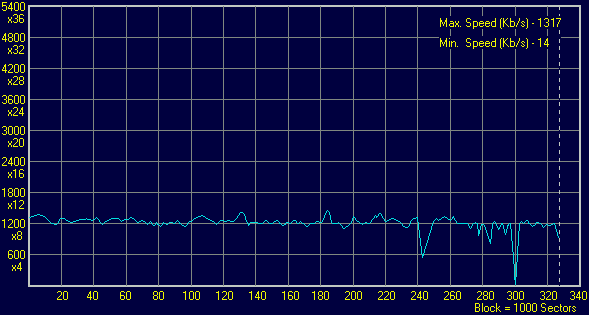 The "golden" disc was read with quite noticeable fluctuations on the graphs. The amplitude is small but the high frequency of them confuses me. The second recorder read the "golden" disc at lower speed and with less difficulty. The "scratched" one was read by the both drives equally good. Although the reading speed was in the range 8X-12X, the graph fell only where it should do. The scratched disc was read by the both devices only in 65%. ConclusionUndoubtedly, a release of the 16x model of a CD-RW is some kind a break-through in the industry of computer optical data storing and recording systems, but I think that a purchase of such model today would be unjustified step. Of course, the Yamaha CRW2100E has some positive sides but as a recording device - I wouldn't recommend it. I suppose that the main requirement to the CD-RW drive is a quality and possibly quick recording. I can't say that the tested recorders from Yamaha meet it. Anyway, if you need exactly a 16x model, you'd better wait until it becomes more widespread (it concerns both CD-R, and CD-RW drives). I hope that in future revisions the situation would be improved, but now Yamaha hurried with debuting of their new model of CD-RW drive… Test programs:
Write a comment below. No registration needed!
|
Platform · Video · Multimedia · Mobile · Other || About us & Privacy policy · Twitter · Facebook Copyright © Byrds Research & Publishing, Ltd., 1997–2011. All rights reserved. |